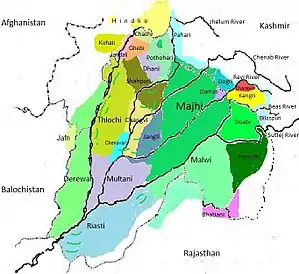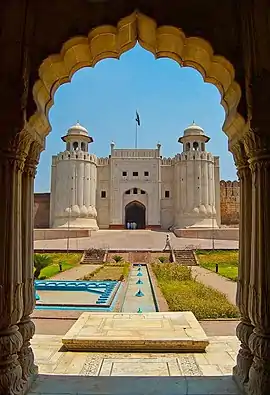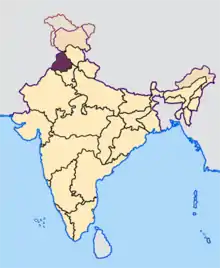Majha
Majha (Punjabi: ਮਾਝਾ (Gurmukhi), ماجھا (Shahmukhi); Mājhā) is a region located in the central parts of the historical Punjab region split between India and Pakistan.[1] It extends north from the right banks[note 1] of the river Beas, and reaches as far north as the river Jhelum.[2] People of the Majha region are given the demonym "Mājhī", or the more widely used Majhail. Most inhabitants of the region speak the Majhi dialect, which is the basis of the standard register of the Punjabi language.[3] The most populous city in the area is Lahore on the Pakistani side and Amritsar on the Indian side of the border.

During the partition of India in 1947, the Majha region of Punjab was split between India and Pakistan when the Indian Punjab and Pakistani Punjab were formed. The Majha region of Indian State of Punjab covers the area between Beas and Ravi rivers, including the area on the north of Sutlej, after the confluence of Beas and Sutlej at Harike in Tarn Taran district, extending up to the Ravi River, which is all part of the Majha region in India.[4] This region contains thirteen districts of the Pakistani province of Punjab, including the cities of Lahore, Faisalabad, Gujranwala, Gujrat, and Sialkot. Four districts of Indian state of Punjab – Amritsar, Tarn Taran, Gurdaspur, and Pathankot.
The people of the Majha region have been historically known for their warrior-like nature. The Majha region is called the "Sword Arm of the Country", due to it contributing disproportionately to the Officer as well as Orderly ranks of the Armies of both India and Pakistan. [5] The Sikh Empire was founded in the Majha region, and so the region is also sometimes referred to as "the cradle of the brave Sikhs." [6]
History

The word "Mājhā" means the "central" or the "heartland". The Majha region is geographically located in the middle (or central part) of the historic Punjab region, hence giving it the name Majha.[7] It includes a considerable portion of the Bari Doab (the region between the rivers Beas and Ravi) and the Rechna Doab (the region between the rivers Ravi and Chenab), and a smaller portion of the Jech Doab region (the region between the rivers Jhelum and Chenab).[8]
The Majha region of historical Punjab region spans northward from the right banks[note 1] of river Beas, and extends up to river Jhelum at its northmost,[2] making it the largest regions of historic Punjab.
The Indian state of Punjab has continued to recognize the Majha region through maintaining the districts that have historically belonged to the Majha region. In Pakistan, the Majha city of Lahore was selected as its provincial capital, which the remaining Majha districts were either maintained, or their borders blurred as the boundaries were divided between districts Bahawalpur, Dera Ghazi Khan, Multan, and Rawalpindi,[9] Sahiwal and Sargodha.
Districts of Majha
The following districts are classified as Majha.
| Majha districts of Punjab, India | Majha districts of Punjab, Pakistan |
|---|---|
| Amritsar | Gujranwala |
| Gurdaspur | Gujrat |
| Pathankot | Hafizabad |
| Tarn Taran | Kasur |
| Lahore | |
| Narowal | |
| Sheikhupura | |
| Sialkot |
Tourist attractions
India

- Gurudwara Shaheed Ganj Sahib, Amritsar
- Baba Atal Sahib, Amritsar
- Maharaja Ranjit Singh Museum, Amritsar
- Company Bagh, Amritsar
- Gurdwara Sri Tarn Taran Sahib, Tarntaran
- Jallianwala Bagh, Amritsar
- Punjab State War Heroes' Memorial & Museum, Amritsar
- Bhagwan Valmiki Tirath Sthal ,Amritsar
- Sadda Pind, Amritsar
- Gurudwara Bir Baba Budha Sahib
- Chheharta Sahib, Amritsar
- Gurudwara Goindwal Sahib, Tarntaran
- Urban Haat, Amritsar
- Ram Bagh Palace, Amritsar
- Partition Museum, Amritsar
- Harike Pattan bird sanctuary, Tarn Taran
- Durgiana Temple, Amritsar
- Walled City of Amritsar
- Gobindgarh Fort, Amritsar
- Mukteshwar Mahadev Temple, Pathankot
- Ranjit Sagar Dam, Pathankot
- Shahpur Kandi Fort, Pathankot
- Nurpur Fort, Pathankot
- Gurdwara Kandh Sahib, Batala
- Shamsher Khan's tomb, Batala
- Pul Kanjri, Amritsar
- Wagah-Attari border ceremony, Attari border between Amritsar India and Lahore Pakistan.
Pakistan

- Badshahi Mosque, Lahore
- Bagh-e-Jinnah (Lawrence Gardens), Lahore
- Begum Shahi Mosque, Lahore
- Haveli of Nau Nihal Singh, Lahore
- Hazuri Bagh, Lahore
- Hiran Minar, Sheikhupura
- Lahore Fort (Shahi Qila), Lahore
- Lahore Museum, Lahore
- Gurdwara Darbar Sahib Kartarpur, Kartarpur
- Gurdwara Dera Sahib, Lahore
- Gurdwara Janam Asthan, Nankana Sahib
- Gurdwara Janam Asthan Guru Ram Das, Lahore
- Omar Hayat Mahal, Chiniot
- Samadhi of Ranjit Singh, Lahore
- Shahi Hammam, Lahore
- Shalimar Gardens, Lahore
- Sunehri Mosque, Lahore
- Tomb of Jahangir, Lahore
- Wagah-Attari border ceremony, Attari border between Amritsar India and Lahore Pakistan.
- Walled City of Lahore, Lahore
- Wazir Khan Mosque, Lahore
Notable residents Of Majha(India)
- Baba Deep Singh Ji (1682–1757).
- Maharaja Ranjit Singh of Punjab (1780–1839), the founder of the Sikh Empire.
- Hari Singh Nalwa (1791–1837), renowned warrior and Commander-in-chief of the Sikh Khalsa Army, the army of the Sikh Empire.
- Bhai Bidhi Chand Chhina (1640), the greatest Sikh warrior and religious preacher at the time of Guru Hargobind Sahib Ji.
- Akali Phula Singh Ji (1761 – 1823), highly respected Akali Nihang Sikh general and Jathedar of the Khalsa Panth.
- Sham Singh Atariwala (1790 - 1846), the general of the Sikh Empire.
- Allama Iqbal, Pakistan's national poet.
- Musarrat Nazir, Pakistani Punjabi folk singer of Kashmiri descent.
- Saifuddin Kitchlew, Indian freedom fighter of Kashmiri descent.
- Baba Baghel Singh, who occupied Delhi
- Akshay Kumar
- Baba Gurdit Singh, SS Komagata Maru
- Bhai Maha Singh
- Kapil Sharma
- Dara Singh wrestler
- Gurdial Singh Dhillon, ex-speaker of Lok Sabha, India
- Jagbir Singh Chhina, freedom fighter.
- Gurpreet Singh (shooter), winner of two medals in Commonwealth Games, Delhi
- M. S. Gill, former chief Election Commissioner of India and former sports Minister of India
- Mai Bhago
- Pratap Singh Kairon, ex-Chief Minister of Punjab
- Surender Mohan Pathak, Novelist
- Teja Singh Samundri, founder of SGPC
- Baba Sohan Singh Bhakna, Founder and President of Gadar party
- Bharti Singh
- Amrinder Gill
- Manmohan Singh former prime minister of India
- Chandan Prabhakar
- Sardar Baj Singh, Sikh general and governor.[10]
- Bhai Bhag Singh Bhikhiwind, leader of the Ghadar Party (1914)[11]
- Sardar Chhajja Singh Dhillon, a renowned Sikh warrior of the early 18th century.
- Prem Dhillon
- Jordan Sandhu
- Keeratdeep Singh
Photo gallery
 Ranjit Sagar Dam, Shahpur Kandi
Ranjit Sagar Dam, Shahpur Kandi Ravi River
Ravi River Emperor Akbar crowning platform, Kalanaur-Gurdaspur, India
Emperor Akbar crowning platform, Kalanaur-Gurdaspur, India Golden Temple and the Akal Takht, Amritsar
Golden Temple and the Akal Takht, Amritsar.jpg.webp) Badshahi Mosque, Lahore
Badshahi Mosque, Lahore Lahore Fort, Lahore
Lahore Fort, Lahore Lahore Museum, Lahore
Lahore Museum, Lahore Shalimar Gardens
Shalimar Gardens Jahangir's Tomb, Lahore
Jahangir's Tomb, Lahore
See also
Notes
- The left/right bank of a river is determined by looking in the direction of flow of the river (facing downstream).
References
- Discover India http://www.discoveredindia.com/punjab/about-punjab/regions-in-punjab.htm
- Grover, Parminder Singh (2011). Discover Punjab: Attractions of Punjab. Parminder Singh Grover. p. 179.
- Advanced Centre for Technical Development of Punjabi Language, Literature and Culture, Punjabi University, Patiala Punjabi University, Patiala.
- Punjab Data, Know Everything About Punjab http://www.punjabdata.com/Majha-Malwa-Doaba.aspx
- Mahmood, Cynthia Keppley (1996). Fighting for Faith and Nation: Dialogues with Sikh Militants (Contemporary Ethnography), p. 153. Philadelphia, University of Pennsylvania.
- Sandhu, Gulzar Singh (2004). Gods on Trial and Other Stories, p. 132. Diamond Pocket Books. ISBN 8128808087
- Vipul Punjabi https://vipulpunjabi.wordpress.com/regions-and-districts/majha/
- Kakshi, S.R.; Pathak, Rashmi; Pathak, S.R.Bakshi R. (1 January 2007). Punjab Through the Ages. Sarup & Sons. ISBN 978-81-7625-738-1. Retrieved 12 June 2010.
- Rawalpindi: Majha, Punjab, Islamabad, Tribes and Castes of Rawalpindi District, Rawalpindi District, Demography of Rawalpindi District https://www.amazon.it/Rawalpindi-Punjab-Islamabad-District-Demography/dp/6131076170
- Singh, Raj Pal (1998). Banda Bahadur and His Times p. 22. Harman Pub. House, 1 Aug 1998.
- http://centralsikhmuseum.com/today-in-sikh-history-5th-september/

